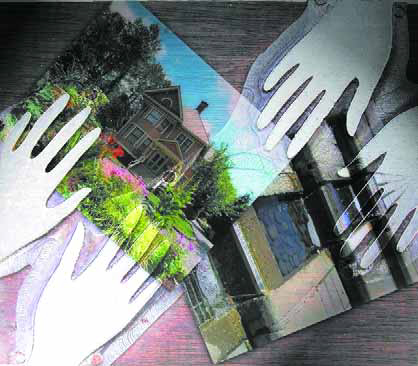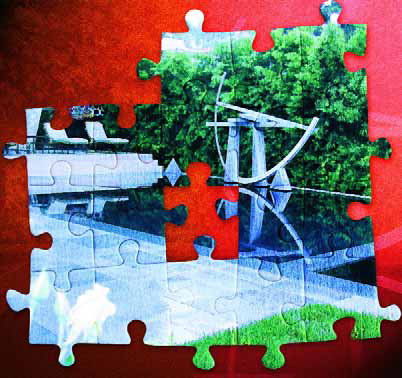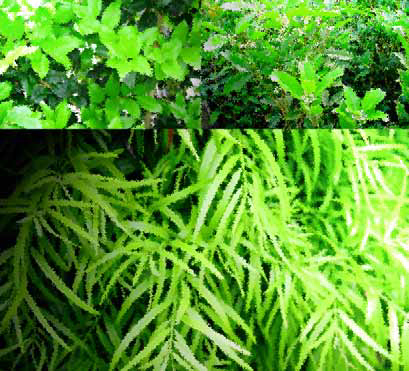Natural Companions
Most of my clients don't know a Pittosporum from a Loropetalum - nor would I expect them to. Unfortunately, however, this often leaves me to describe plants to them, a process that often makes me feel like I'm reenacting that television commercial where the homeowner tries to mimic the creature seen crawling across the kitchen floor for an exterminator: I'll stand there with my arms up or out, attempting to look like the botanical specimen I'm suggesting for use in their garden. One of the easiest groups of plants to describe in this or any other way is a collection I call the strappy-leaf plants. I didn't make up the term, and I'm sure many of you have also used it yourselves to describe plants with foliage that looks like straps - generally long strips that emerge from a central clump and arc up, sometimes flopping over to create
Although we think of them together as activities in the world of exterior design, watershaping and landscaping have some significant distinctions. The watershapers who design and build pools, spas, fountains and waterfeatures, for instance, fully intend them to be structurally static and unchanging (a firm hope, anyway, especially in earthquake country) once they are completed. By contrast, the landscape professionals who design and install the gardens, trees and plants that may surround a watershape work with dynamic, constantly changing materials. What this means is that perfection is a much more elusive quality for landscape professionals by comparison to watershapers. Indeed, for us on the green side, achieving the kind of perfection one often
Although we think of them together as activities in the world of exterior design, watershaping and landscaping have some significant distinctions. The watershapers who design and build pools, spas, fountains and waterfeatures, for instance, fully intend them to be structurally static and unchanging (a firm hope, anyway, especially in earthquake country) once they are completed. By contrast, the landscape professionals who design and install the gardens, trees and plants that may surround a watershape work with dynamic, constantly changing materials. What this means is that perfection is a much more elusive quality for landscape professionals by comparison to watershapers. Indeed, for us on the green side, achieving the kind of perfection one often
Like most everything in life, "Natural Companions" has evolved through the years. When I first started writing this column in 1999, I focused primarily on topics related to combining plants and watershapes and wrote a lot about surrounding hard structures with greenery in sensible and sustainable ways. As the New Year approaches, I've been thinking about how things have changed with the column and where it's now heading. I distinctly recall having the sense about four years ago that
In the October 2005 issue of WaterShapes, I discussed a project that had tested my abilities and helped me to grow as a landscape designer. To that point in my career, I had functioned mainly as a designer focused on planting design. It was quite a step for me to accept the greater responsibility that came with a project that put me in charge of work on the total environment - pool, spa, deck, outdoor amenities and artwork placement as well as the planting plan. I knew going in that project management is a challenge no matter the size or scale of the job. Coordinating various trades, anticipating schedules and materials needs, making on-site design decisions and covering all
It'd be great if every project I was asked to tackle were about the complete environment - not only the planting plan, but also the watershapes, artworks, amenities and everything else a client might desire. That doesn't happen often enough, probably because my portfolio is much richer in planting plans than it is in watershapes. But from time to time I find clients who have faith in me and my abilities as a designer and give me total control. Late last year, I was fortunate enough to come across one such project. I had originally been brought in to
It's that time of year when our thoughts begin turning to the beautiful colors of the fall - and the subsequent bareness of winter. Whether you're in the coldest northern reaches or enjoy the relative warmth of the Sunbelt, we all are aware that fall is a transition to a time when the annuals will fade once and for all and the deciduous plants will drop their leaves. But I propose that it doesn't have to be so - or at least that we can minimize the seasonal holes in our gardens through thoughtful use of evergreen trees and shrubs. These are the most abundant of all plant types, after all, and the bones of
Please forgive me as I revisit themes from a couple of my past columns. One was written earlier this year on why we do what we do, while the other was published several years ago - back when I first began writing for WaterShapes - and was all about a subject dear to my heart: roses. Recent events in my family have given me time and the need to sort through the past, and the experience has deepened my appreciation of gardens, their emotional power and how they come to reflect our clients and ourselves. I'd like to share this process of discovery to define what I see as the essence of what we all try to do as professionals - and encourage all of you to
It'd be great if we all lived in a world where a handshake was sufficient to seal a deal and no legal documents were needed. Unfortunately, however, we live in a society in which contracts are a necessity for most of us in business. When I first started out, I took on jobs without signed contracts, and for the first few years I didn't run into any problems. As I moved into higher-dollar projects, however, I developed a quick appreciation for the value of a contract when a client refused to pay for my services as we'd verbally agreed he would. Although I realize there are people out there who run strong, successful businesses without a need for contracts and rarely run into problems, for most of us I believe it is a critical component of every job. The purpose of any contract is to





















